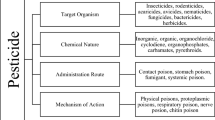Abstract
The bioremediation of petroleum contaminated soil was investigated using a laboratory scale aerated reactor. The Indigenous bacteria, Stenotrophomonas multophilia, were isolated from the contaminated sites near to Jordan Petroleum Refinery and used further in the bioremediation experiments. First order kinetic equation has been proven to satisfactorily describe the biodegradation of petroleum contained in soil in the presence of the isolated bacteria. The results also showed that the first order kinetic constants for the different bioreactors vary between 0.041 and 0.0071/day. The overall kinetic constant k′ was determined based on food-to-microorganisms ratio and found to be 0.02/day.









Similar content being viewed by others
References
Abbassi, B. E., & Shquirat, W. D. (2005). Ex-situ bioremediation of petroleum contaminated soil using isolated indigenous bacteria. Alexandria Science Exchange, 26(3), 224–229.
Alexander, M. (1999). Biodegradation and Bioremediation. New York: Academic Press.
Antizar-Ladislao, B., Lopez-Real, J., & Beck, A. J. (2005). Laboratory studies of the remediation of polycyclic aromatic hydrocarbon contaminated soil by in-vessel composting. Waste Management, 25, 281–289.
Atlas, R. M., & Cerniglia, C. E. (1995). Bioremediation of petroleum pollutants. BioScience, 45(5), 332–338.
Barathi, S., & Vasudevan, N. (2001). Utilization of petroleum hydrocarbon by Pseudomonas fluorescens isolated from a petroleum contaminated soil. Environmental International, 26(5), 413–416.
Bock, M., Kampfer, K., & Dott, W. (1994). Isolation and characterization of heterotrophic aerobic bacteria from oil storage caverns in northern Germany. Applied Microbiology and Biotechnology, 42, 463–468.
Bonaventura, C., & Johnson, F. M. (1996). Healthy environment for healthy people: Bioremediation now and tomorrow. Environmental Health Perspective Supplements, 105(1), 5–21.
Boonchan, S., Britz, M. L., & Stanley, G. A. (2000). Degradation and mineralization of high-molecular-weight polycyclic aromatic hydrocarbons by defined fungal-bacterial cocultures. Applied and Environmental Microbiology, 66(3), 1007–1019.
Greene, E. A., Kay, J. G., Jaber, K., Stehmeier, G., & Voordouw, G. (2000). Composition of soil microbial communities enriched on a mixture of aromatic hydrocarbons. Applied and Environmental Microbiology, 66(12), 5282–5289.
Hutchins, S. R., Sewell, G. W., Kovacs, D. A., & Smith, G. A. (1991). Biodegradation of aromatic hydrocarbons by aquifer microorganisms under denitrifying conditions. Environmental Science and Technology, 25, 68–76.
Hwang, E., Namkoong, W., & Park, J. (2001). Recycling of remediated soil for effective composting of diesel-contaminated soil. Compost Science and Utilization, 9(2), 143–149.
Kanaly, R. A., Bartha, R., Watanabe, K., & Harayama, S. (2000). Rapid mineralization of benzopyrene by a microbial consortium growing on diesel fuel. Applied and Environmental Microbiology, 66, 4205–4211.
Li, H., Liu, Y. H., Luo, N., Zhang, X. Y., Luan, T. G., Hu, J. M., et al. (2006). Biodegradation of benzene and its derivatives by a psychrotolerant and moderately haloalkaliphilic Planococcus sp. Strain ZD22. Research in Microbiology, 157, 629–636.
Murray, P. R., Baron, E. J., Pfaller, M. A., Tenover, F. C., & Yolken, H. R. (1995). Manual of Clinical Microbiology. Washington D.C.: ASM Press.
Reardon, K. F., Mosteller, D. C., Rogers, J. B., DuTeau, N. M., & Kee-Hong, K. (2002). Biodegradation kinetic of aromatic hydrocarbon mixtures by pure and mixed bacterial cultures. Environmental Health Perspectives, 110(12), 1005–1012.
Strauss, J. M., & du Plessis, C. A. (2000). Empirical model for biofiltration of toluene. Journal of Environmental Engineering, 126(7), 644–648.
Williams, D. L., Kriel, K. D., Stewart, G. A., Hulse, R. C., Holsomback, J. E., & Stewart, J. R. (1998). Bioremediation of oil-contaminated soils by stimulating indigenous microbes. Environmental Geosciences, 5(1), 1–9.
Author information
Authors and Affiliations
Corresponding author
Rights and permissions
About this article
Cite this article
Abbassi, B.E., Shquirat, W.D. Kinetics of Indigenous Isolated Bacteria used for Ex-Situ Bioremediation of Petroleum Contaminated Soil. Water Air Soil Pollut 192, 221–226 (2008). https://doi.org/10.1007/s11270-008-9649-4
Received:
Accepted:
Published:
Issue Date:
DOI: https://doi.org/10.1007/s11270-008-9649-4




